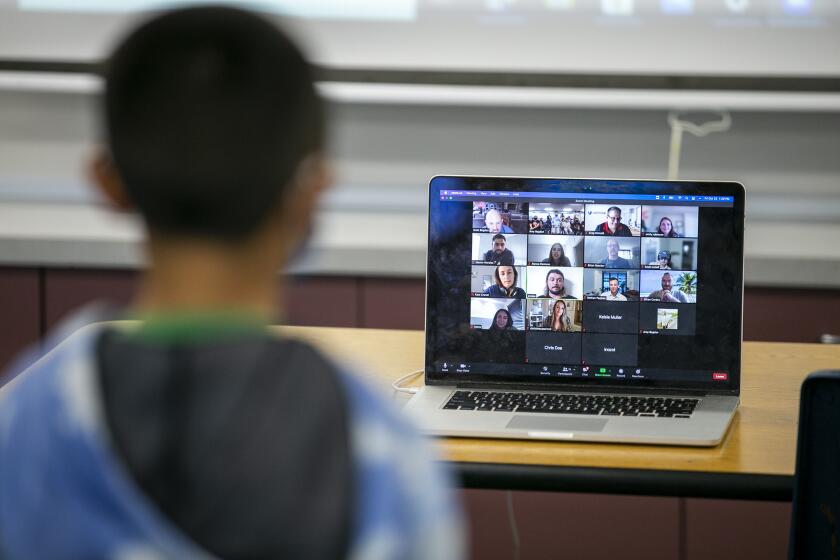Column: Obsolete mission school project should get a thought-provoking replacement
One of my embarrassing parenting episodes occurred many years ago during the time-honored fourth-grade mission project.
Of course I had remembered building my own sugar-cube structure when I was in elementary school — that’s how long this project has been around. And after a few years of living in Newport Beach, where motherhood is as competitive as the Olympics, you would think I’d have been better prepared.
But around 10 p.m. the night before my son and his classmates were to gather in their school’s multipurpose room to construct their model missions, there I was ransacking local market shelves for last-minute supplies.
Parents were invited to participate but were warned repeatedly not to take over the projects or provide any of the prefab mission kits sold at art supply stores. This project belongs to the students, we were told. You parents are only helpers.
Ha.
Again, I live in Newport Beach, where parents generally don’t do hands-off and kids are considered failures if their projects aren’t meticulously curated.
So when I showed up to “help” it didn’t take long for panic to set in. As I surveyed the room, all the other parents were expertly leading construction of Architectural Digest-worthy structures, replete with impressive design elements such as bell towers and accessories like plastic barnyard animals and miniature gardens.
Meanwhile, one student in my son’s group was out sick and the other was mostly AWOL. It was up to my son and his artistically challenged mother to figure it out.
A few hours and another supply run later, we had assembled what appeared to be, though hardly award caliber, at least a passable mission. The missing kid made a last-minute appearance. Then, as the two boys lifted the board on which their mission rested to carry it back to their classroom, the whole thing collapsed into a sugary pile of wasted effort.
The San Andreas fault could not have rendered a more thorough destruction.
I recalled this charming story recently when I learned that the California mission project is officially being relegated to the dust heap of discarded educational endeavors. Beginning this school year, sugar cubes are now safe from exploitation as faux building material.
Despite my inglorious record of mission-project failure, I can’t help having some mixed feelings about this development.
It’s not that I don’t appreciate the sound reasons for abandoning it, not the least of which is that the project really has limited educational value. As the new California curriculum standards state, emphasis should be on “the daily experience of missions rather than the building structures themselves.”
What’s more, our schools have for too long glossed over the sordid nature of the mission system, which enslaved and brutalized the native population. Making play houses of sugar does nothing to help students understand this complicated history.
But my nostalgia isn’t for the loss of this particular project per se. Rather, it is rooted in my suspicion that the mission project and many other experience-based learning opportunities have been lost not so much because they aren’t worthwhile, but because there simply isn’t time for them anymore.
I recall another instance when my son was in fifth grade and an entire school day was given over to re-creating the immigrant experience at Ellis Island. It was a terrific project and the kids learned a lot.
Even so, a few years later when my younger son was entering fifth grade I was told that the Ellis Island project was no more. The reason, his teacher told me, was that even the loss of one day of traditional instruction made it too difficult to keep up with the required curriculum.
We have seen a similar retrenchment from many other hands-on projects. Even the ever-popular science fair, with its baking soda volcanos and potato batteries, has been subjected to harsh scrutiny in recent years as critics charge that such events have become exercises in parenting excess, undue stress, and misguided expectations about how much students actually benefit.
All this questioning and rethinking might prove to be healthy if the old project standbys are replaced by more thought-provoking alternatives. It’s certainly encouraging that we’ve recently begun to see a push-back against the standardized-test-driven culture in our schools in favor of a greater focus on experiential learning.
Or so we’ve been told. Many are still waiting to see, given the continued anxiety over which way scores are headed (flat statewide, up in much of coastal Orange County) in the third year of the new standardized tests.
The doomed mission project aside, it would be wonderful to see a blossoming of substantive research-based project learning. In such a world it wouldn’t only be about students making something with some connection to their studies. It would also mean involving kids in activities that compel them to ask probing questions, compile and analyze information, solve problems, and present ideas and findings.
Rather than taking time away from what students are meant to learn, these projects would lead them to a deeper understanding of their required academic content.
So adios mission project. I’m not sure how much you’ll be missed, but let’s hope that whatever replaces you gives future 9-year-olds a rich, nuanced experience that brings history to life.
That and a lot less sugar.
PATRICE APODACA is a former Newport-Mesa public school parent and former Los Angeles Times staff writer. She lives in Newport Beach.
All the latest on Orange County from Orange County.
Get our free TimesOC newsletter.
You may occasionally receive promotional content from the Daily Pilot.




